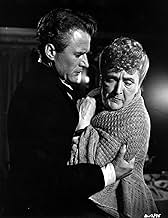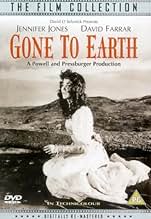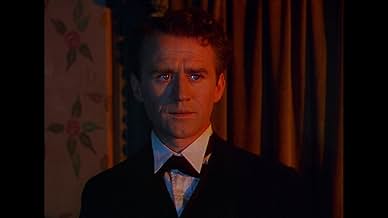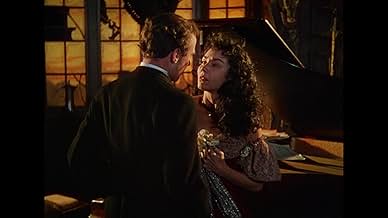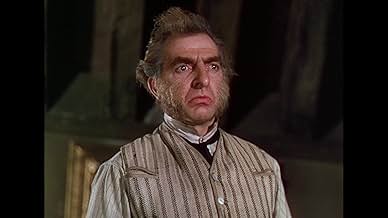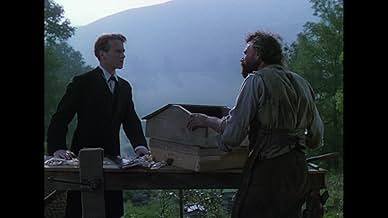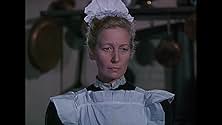AVALIAÇÃO DA IMDb
6,9/10
1,7 mil
SUA AVALIAÇÃO
Uma bela cigana supersticiosa e apaixonada por animais é muito desejada por um nobre caçador de raposas, mesmo depois de ela se casar com um clérigo.Uma bela cigana supersticiosa e apaixonada por animais é muito desejada por um nobre caçador de raposas, mesmo depois de ela se casar com um clérigo.Uma bela cigana supersticiosa e apaixonada por animais é muito desejada por um nobre caçador de raposas, mesmo depois de ela se casar com um clérigo.
- Direção
- Roteiristas
- Artistas
- Prêmios
- 3 vitórias e 1 indicação no total
Arthur Mainzer
- Chapel elder
- (as Arthur Reynolds)
- Direção
- Roteiristas
- Elenco e equipe completos
- Produção, bilheteria e muito mais no IMDbPro
Avaliações em destaque
I believe I saw this movie perhaps 50 plus years ago, as a young man. It must have been in the mid 1950s or around then. I found Jennifer Jones to be a marvelous actress in this movie and found that to be true in other movies she starred in. But I was overwhelmingly struck with the beauty of the Shrophire countryside which to some extent was almost as much of an attraction to me as Jennifer Jones. I have searched for a long time for this movie...but all I could truly remember of it , with the obvious exception of Miss Jones, was the scream or shout at the end of it ----Gone to Earth. I only know have found out what the meaning of that call was. I will be wanting to purchase this movie soon. Don Berghuis
I saw this glorious film when it first appeared. The following week I tracked it down to a small London cinema where they screened single films continuously several times a day without supporting features. I hadn't intended seeing it more than once on this occasion but I can recall being so mesmerised that I watched the programme through three times. Clearly I was out of step with the climate of critical opinion. The reviewers had slated it and the audience around me was distinctly hostile. There was a lot of fidgeting and derisory shouts. Quite a few walked out. Behaviour was often bad in British cinemas in the 'fifties particularly if viewers got bored. The manager called the police in during a screening I attended a few years later of "The Trouble WIth Harry" and I can even remember screaming at the usherettes to stop talking when I first saw "A Face in the Crowd". I had to wait many years before I heard good things being said about "Gone to Earth". It was in 1988 when someone introduced a showing of it on British television most enthusiastically. Whatever one thinks about the relative merits of Powell and Pressburger's films (I am clearly in a minority in thinking this their finest) there is no doubt that they are now appreciated in a way they never were when they first appeared. But if passion for what is still considered one of their minor works may seem rather over the top, let me say but one thing; where else in the whole of cinema is there a more haunting and magical evocation of English landscape! Christopher Challis, a brilliant cinematographer, is the real star of the film. Undoubtedly (and this is perhaps at the core of its original problems) style matters more than content. The plot is little more than Victorian melodrama - lecherous squire deflowers simple country girl who has married local vicar - and the dialogue is curiously stilted. However this hardly matters in a work cinematically choreographed with such brilliance. The final foxhunting sequence, where the film's many strands are brought together, is visually and aurally one of the most spellbinding in all cinema. The huntsman's cry of "Gone to earth!" at the very end has haunted me for well over half a lifetime.
about a wild child in rural England in 1897. Half gypsy, the girl (Jennifer Jones) worships nature, animals, superstitions, etc. but has an odd, eerie "one-ness" with the world. However, when sex enters the picture, her world spins out of control. A timid parson (Cyril Cusack) marries her but chains her to a sexless marriage. She runs off with a lusty squire (David Farrar) and lives in his ramshackle estate. Truly offbeat story, totally gorgeous cinematography by Christopher Challes, and good performances by all make this watchable. Sadly, the US version had 30 minutes lopped off and shows it. The Brit version, titled "Come to Earth" is supposedly superior. Symbolism is worthy of any good Lawrencian story where love is in opposition to nature and where sex can only survive outside marriage. Jones looks great. Oddly forgotten now, she was not your average leading lady, and like Meryl Streep or Glenn Close or Bette Davis, chose to play all sorts of "character" parts rather than be confined by Hollywood. Worthy of the Emeric Pressburger/Michael Powell canon; this might be a great film!
I now own this title on a DVD since it has recently been issued in the UK in its' new digital, re-mastered version.The colours are certainly impressive.I also visited Much Wenlock, Shropshire recently and photographed us next to the town clock (seen at the beginning of the film) which commemorates Queen Victoria's diamond jubilee in 1897, the year the film is set.
The music of Brain Easdale has a haunting quality and I don't think enough credit has been given to this by other reviewers since it adds immeasurably to the atmosphere of the film.While in Much Wenlock I bought a review of Mary Webb's short stories, including "Gone To Earth" as I always like to read the book from which films are adapted (to see where the film plot diverges).Yes it is rather a corny Victorian melodrama but the acting is convincing enough.I could not help but think there were certain parralls with her (Jennifer Jones) previous epic of "Duel in the Sun" (1946).For Lewton McCanless read Jack Reddin, for Jesse McCanless read Reverend Marston, for Mrs Marston read Senator McCanless etc etc.In both films Jennifer Jones plays a half breed, Native American to Gypsy and is discriminated on accordingly by society.
This film has been hidden from view for too long since its' release in 1950 by the major tv networks and viewers should certainly see this Michael Powell/Emeric Pressburger film if they can, especially if they enjoyed their other films like "Black Narcissus", "The Red Shoes" or "A Matter of Life & Death" from 1946.Technicolour has rarely been put to such good use.I suppose the main reason why you would watch "Gone To Earth" is to see the ravishing Jennifer Jones in the role of Hazel Woodus although all the cast are very effective.If viewers would like to see another example of David Farrar I saw him in "They Met in the Dark (1944) with James Mason and Joyce Howard.
The music of Brain Easdale has a haunting quality and I don't think enough credit has been given to this by other reviewers since it adds immeasurably to the atmosphere of the film.While in Much Wenlock I bought a review of Mary Webb's short stories, including "Gone To Earth" as I always like to read the book from which films are adapted (to see where the film plot diverges).Yes it is rather a corny Victorian melodrama but the acting is convincing enough.I could not help but think there were certain parralls with her (Jennifer Jones) previous epic of "Duel in the Sun" (1946).For Lewton McCanless read Jack Reddin, for Jesse McCanless read Reverend Marston, for Mrs Marston read Senator McCanless etc etc.In both films Jennifer Jones plays a half breed, Native American to Gypsy and is discriminated on accordingly by society.
This film has been hidden from view for too long since its' release in 1950 by the major tv networks and viewers should certainly see this Michael Powell/Emeric Pressburger film if they can, especially if they enjoyed their other films like "Black Narcissus", "The Red Shoes" or "A Matter of Life & Death" from 1946.Technicolour has rarely been put to such good use.I suppose the main reason why you would watch "Gone To Earth" is to see the ravishing Jennifer Jones in the role of Hazel Woodus although all the cast are very effective.If viewers would like to see another example of David Farrar I saw him in "They Met in the Dark (1944) with James Mason and Joyce Howard.
Among the strangest, and loveliest, of the Archers films. As with so many of their films, its real subject is the profound, almost mystical, connection of people to their physical environment, most notably the British countryside. The much under-rated Jennifer Jones gives an utterly fearless performance, throwing herself into a role that sounds unplayable on paper. The Christopher Challis three-strip Technicolor photography is bold and gorgeous, underlining the central importance of the landscape. Strange in the best possible sense, in that it takes us somewhere we've never really been. Even the Bronte sisters couldn't capture rustic England as well. But they never had the benefit of Technicolor.
Você sabia?
- CuriosidadesThe choir was the real choir from the local Methodist chapel. When he heard them singing, director Michael Powell said they were too good and he wanted them to sound "more ragged, like a choir of country folk" only to be told "But we ARE country folk, Mr. Powell."
- Erros de gravaçãoAs Abel and Hazel Woodus come down the hill to the chapel, the mine engine house disappears and then reappears between shots
- Citações
Hazel Woodus: The world wasn't made in seven days only for Abel Woodus.
- Versões alternativasThe reedited and shortened version titled "The Wild Heart" was produced after a disagreement and court case between director Michael Powell and producer David O. Selznick. Selznick's changes are mainly:- (1) Adding a prologue. (2) Adding scenes explaining things, often by putting labels or inscriptions on them. (3) Adding more close-ups of Jennifer Jones (Selznick's wife). He also deleted a few scenes that he felt weren't dramatic enough. Sadly some of these were major plot points so the story doesn't make as much sense as the original. In his autobiographies, Powell claimed that Selznick only left about 35 mins of the original film. In fact there's a lot more than that. About 2/3 of the original remains.
- ConexõesFeatured in The Late Show: Michael Powell (1992)
Principais escolhas
Faça login para avaliar e ver a lista de recomendações personalizadas
- How long is Gone to Earth?Fornecido pela Alexa
Detalhes
- Data de lançamento
- Países de origem
- Idioma
- Também conhecido como
- The Wild Heart
- Locações de filme
- Empresas de produção
- Consulte mais créditos da empresa na IMDbPro
- Tempo de duração
- 1 h 50 min(110 min)
- Cor
- Proporção
- 1.37 : 1
Contribua para esta página
Sugerir uma alteração ou adicionar conteúdo ausente

